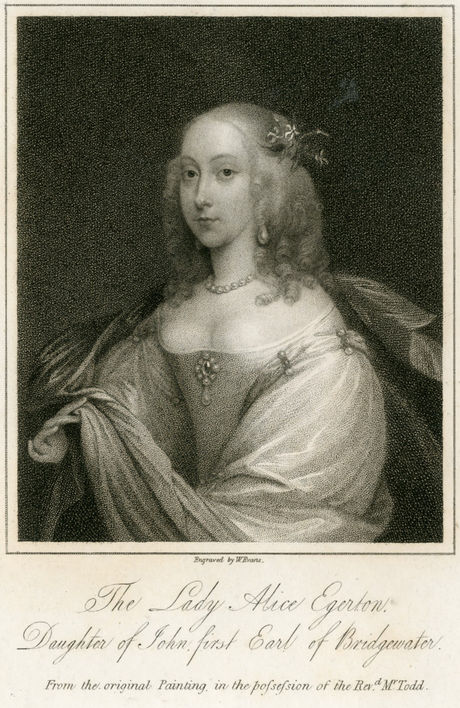by Boyd Brogan

An engraving of Lady Alice Egerton, the daughter of John first Earl of Bridgewater. Fairclough Collection, University of Leicester
From 1632 to 1633, Napier’s patients included Alice and Magdalen Egerton, the youngest daughters of John and Frances Egerton, the Earl and Countess of Bridgewater. Magdalen had ulcerous swellings in her neck which Napier diagnosed as ‘struma’, also known as scrofula or king’s evil. Alice had ‘suffocation of the mother’, a disease that was often simply referred to as ‘the mother’. ‘Mother’ was an early modern term for the womb. In this illness, toxic fluids trapped in the womb caused convulsions and a feeling of being choked. Suffocation of the mother was a ‘disease of virgins’ associated with unmarried, sexually abstinent women. Intriguingly, in 1634 John Milton wrote the part of the ostentatiously virginal heroine in his masque Comus for Alice Egerton to perform.
Napier’s Egerton entries document many standard techniques of early modern medical treatment. Alice and Magdalen took medicines orally, in pills and drinks; by scent therapy, contained in a pomander; through the skin, by means of ointments and medicated plasters; and from anal or vaginal clysters. They underwent bloodletting with a scalpel, and from leeches in the mouth and ‘fundament’. Caustic substances were applied to the skin to create therapeutic sores, or ‘issues’. Their menstrual periods (‘terms’, ‘courses’, ‘them’) were carefully monitored. Excess humours, the principal cause of most diseases, were evacuated in blood, pus, stools, and vomit. Humours were also drawn away from dangerous areas by a pigeon cut in half and pressed to the feet. In his Devotions upon Emergent Occasions (1623), John Donne describes experiencing this treatment.
Magic of various kinds played a significant role in the Egertons’ treatment. Struma could be cured by a coin blessed by the king; Magdalen had already received two of these ‘angels’ when Napier began treating her. Suffocation of the mother was believed to resemble the effects of witchcraft, and at one point Frances Egerton worried that Alice might have been bewitched. Napier gave his Egerton patients a ring, pomander, and ‘sigil’, an engraved pendant. Each was probably inscribed with magical symbols. Objects like these could be effective against natural illnesses as well as witchcraft.
These records reveal the social and spatial relationships through which early modern medical practice was conducted. Many consultations happened at a distance, by letter. Only one of these letters survives, but the contents of others were summarised in Napier’s notes. Messengers brought flasks of urine for analysis. At other times, like many of Napier’s patients, the Egertons came to stay with him at Great Linford. Their family estate at Ashridge in Kent was about fifty miles away, and they also owned a house in London, where some of Magdalen’s treatment took place. The Egertons may have had a preference for astrological medicine, since the Egerton family papers include a nativity (birth horoscope) cast by an astrologer named Richard Piper for a ‘Lady Alice Egerton’ that predicts her medical future. (We cannot be certain that this is the same Alice Egerton, but she is the most likely candidate). But the Egertons also tried other kinds of healing. Around 1628 either Alice or Magdalen was treated by George Hill, an unlicensed London apothecary, and in 1633 Frances Egerton abandoned Napier’s therapies and began to treat her daughters herself.
Alice and Magdalen Egerton’s treatment was embedded in wider networks linking the Napier and Egerton families. These were cemented in 1632, when Napier’s nephew Robert married Penelope Egerton, Alice’s and Magdalen’s older sister. Napier treated Penelope during the difficult pregnancy that followed. Napier’s other nephew and namesake, Richard Napier the younger, was also close to the Egerton family. Also a physician, he frequently assisted Napier in these years, and took over his practice after his death in 1634. Eight of the Egerton entries in Napier’s casebooks are in his hand, and it was to him that the Countess of Bridgewater first confided her concerns about witchcraft. Richard Napier also cast a nativity for the Egertons’ youngest child John, and treated two of their servants: a Frenchwoman named Mrs Tubeuffe, and Alice and Magdalen’s personal attendant Mrs Quicke.
The cases
The spellings in the quotations below have been modernised.
?1623–26. Richard Piper casts a nativity for a ‘Lady Alice Egerton’ who is very likely to be the same person who appears in Napier’s casebooks. It predicts serious illness at the age of nine caused by rotten phlegm (a humour), as well as a rather dubious moral character, prompting someone to note that it has been ‘[w]rong cast’. It is accompanied by a similar nativity for an unknown male (omitted), who might be Alice’s younger brother John. Nothing else is known about Piper.
1627/28. George Hill, an unlicensed apothecary, treats Mrs Quicke and an unnamed 11-year-old daughter of the Egertons. The convulsive symptoms suggest Alice Egerton, but the age and date fit Magdalen better.
16 January 1632. A letter from Napier’s nephew Robert, delivered by Sir Thomas Mydelton, describes Magdalen Egerton’s problems with her eyesight. A build-up of ‘rheum’ has solidified into a ‘kell’ or membrane in one eye, a condition that was sometimes called ‘pin and web’. The entry is marked ‘without consent’, which may imply that Magdalen is not aware Napier’s help is being sought.
6 February 1632. Richard Napier the younger, Robert Napier’s younger brother, asks his uncle to cast an astrological figure to find out if Robert will marry Penelope Egerton. This query is also marked ‘without consent’. It is not clear if Richard is asking in person or by letter. The marriage took place later that year.
September 1632, date unknown. Richard Napier the younger records birthdates for Penelope, Magdalen, and Alice Egerton. These birthdates, corroborated in the Egerton family papers, give Magdalen’s age as seventeen and Alice’s as thirteen. About the same time, the elder Napier casts a nativity figure for the Egertons’ youngest child, John.
9 September 1632. Napier receives another letter from Robert, this time written at Frances Egerton’s request, giving a detailed account of Magdalen’s and Alice’s health. Napier gives each the title ‘Heroina’, indicating their elite status. Here, contradicting the birthdates recorded by Richard Napier the younger, he gives Magdalen’s age as fifteen and Alice’s as twelve. Magdalen has had struma since recovering from smallpox six years previously. Her face is swollen and her body is ‘pletherick’, carrying an excess of humours, perhaps linked to the fact that she has never menstruated. She has undergone bloodletting, purging, and ‘issues’, or therapeutic sores. She is also melancholic, which as well as a state of mind may identify the humour responsible for her disease: struma could be caused by an excess of melancholy. Her vision remains poor. Alice is diagnosed with ‘mother’. Napier describes the typical sensation of a ‘rising’ in the throat, accompanied by frequent convulsions.
18 September 1632 / 20 September 1632 / 1 October 1632. Alice Egerton continues to have fits. Napier receives a flask of her urine and casts an astrological figure with the words ‘matricis suffocatio’ [‘suffocation of the womb’].
8 October 1632. A letter arrives from Frances Egerton. Its contents are not recorded, though it may have prompted a query about spells and witchcraft that appears to the left of this entry.
12 October 1632. An entry for the Egertons’ servant Mrs Quicke, who is ‘full of melancholy and grief’, caused by her ‘naughty’ (wicked) husband. She is likely to have been accompanying Alice and Magdalen as they came to stay with Napier for treatment around this time, departing on 6 November. It was common for Napier’s patients to receive treatment in residence at Linford for a period of days or weeks.
14 October 1632. Richard Napier the younger writes a prescription for ‘The Lady Magdalen’. Napier adds ‘Brigwater’ to the end of her name, and ‘Edgerton Bridgwater’ above it.
15 October 1632. Robert Napier, who is now married to Penelope Egerton, writes to his uncle from the Egerton’s house at Ashridge. The letter conveys Frances Egerton’s concerns that, rather than suffering from a natural illness, her daughter Alice Egerton may have been bewitched. The suspect is the estranged husband of Alice and Magdalen’s attendant Mrs Quicke. Male witches were less common than female ones, but not unknown, and Mr Quicke has also previously been suspected of bewitching Mrs Quicke herself. The letter notes that Mrs Quicke, presumably accompanied by Alice and Magdalen, is currently staying with Napier at Linford, and asks Napier to conceal the letter from her.
15 October 1632. Richard Napier the younger notes in his uncle’s casebook the arrival of Robert Napier’s letter at Linford. He casts an astrological figure asking ‘whether the suspicion of witchcraft is true’. Nothing indicates what he concludes.
22 October 1632. The Egerton sisters, still staying with Napier, are visited by Lady Tyrringham. The Tyrringhams were a wealthy local family. This may be Anne Tyrringham, whom Napier was also treating for suffocation of the mother around this time. She later married Richard Napier the younger.
30 October 1632. Mrs Quicke brings Napier her urine. She has ‘shooting’ in her head, heart, and back.
1 November 1632. Preparing for the Egertons’ departure, Napier prescribes ‘vomits’ (emetics) and ‘diet drinks’ for them to take at home, along with a ring for Alice and a pomander for Magdalen. The names here may have been accidentally reversed, since Napier usually prescribed pomanders for Alice’s illness, suffocation of the mother. This kind of pomander was deliberately foul-smelling, which was thought to force the swollen womb back down. Like the ring, it may also have been inscribed with magical symbols.
2 November 1632 / 3 November 1632. Magdalen Egerton brings her urine to Napier. He casts a figure inquiring ‘whether I can do her good’. It is not clear if Napier or Magdalen is asking, but the query itself is a standard one: astrological medicine relied on the right combination of patient and physician for a successful cure. The following day Richard Napier the younger casts another figure under Magdalen’s name.
6 November 1632. The Egertons return home, in a party that includes Richard Napier the younger, and Napier’s curate and medical assistant Ralph Ruddle.
15 November 1632 / 20 December 1632. Letters arrive from Mrs Quicke. Nothing about the first is recorded, but the second reports that Magdalen’s face has swelled up again. Her mother plans to treat this by restricting her meals. Napier thinks this would be harmful.
8 February 1633. Richard Napier the younger records a query from Mrs Quicke, who wants to know when to apply leeches to Magdalen, and whether Alice ‘should take anything to prevent her fits before the spring’. This entry suggests the importance of Mrs Quicke’s role in administering the Egerton sisters’ medical care.
21 February 1633. Another letter from Mrs Quicke, recorded partly by Napier and partly in a different hand. Magdalen has menstruated, but her face has swelled up once more; mention of a ‘fall’ suggests she has collapsed or convulsed (epilepsy was known as ‘the falling sickness’). Napier’s medicines are not helping. Magdalen’s symptoms seem to have been brought on by his ‘strong purging pills’, and Alice’s ‘vomit’ has made her ill.
28 March 1633 / 29 March 1633. The Egertons begin a second period of treatment in residence. Later entries suggest they departed around 14 May, though they may not have stayed at Linford continuously between these dates. The day after their arrival, Magdalen brings Napier a urine sample. As well as struma she has ‘heavy sad melancholy’. Her menstruation has been followed by ‘flushing’, though she now looks pale.
5 April 1633. Another of the Egertons’ servants, Mrs Tubeuffe, is suffering from haemorrhoids and ‘the whites’, a vaginal discharge. She has also been ‘slandered’ by a fellow-servant who claims she wants to sleep with him (‘Mrs’ does not imply that she was married). For astrological purposes, Napier translates Mrs Tubeuffe’s French birthdate to its English equivalent. France had adopted the Gregorian calendar, which was ten days ahead of the Julian dates used in England.
5 April / 6 April 1633. Napier casts an astrological figure asking whether Magdalen Egerton can be cured. Again contradicting earlier entries, on this occasion he gives her age as 19. The next day, Alice Egerton provides a urine sample
22 April 1633 / 23 April 1633 Mrs Quicke has ‘obstruction of the spleen’, a condition that was associated with melancholy. This may suggest a physiological source for the grief and melancholy recorded in her previous entry. The following day she brings her daughter, who has pains in her side and fits of vomiting (‘cast[ing]’). Napier again notes ‘spleen’.
28 April 1633. Napier again casts a figure asking whether Magdalen will recover.
13 May 1633 / 14 May 1633. The Egertons are ready to depart, taking medical supplies, listed by Richard Napier the younger, that include ‘blistering plasters’ and ‘forty leeches’ for Magdalen Egerton. A separate ‘Note of directions’ written by Napier himself gives instructions for treating Magdalen’s ‘flushing heat’, including ‘a pigeon slit, the bloody part to the soles of her feet’, and ‘four leeches to the haemorrhoid veins’. Her sister has ‘griping in her belly’ and headaches: she should ‘smell to her pomander’ and take ‘purging diet ale . . . in the same manner as her ladyship took it here with us at Linford’. The note’s recipient, perhaps Mrs Quicke, is addressed directly: ‘you have three ounces of comfortable lozenges to give to the Lady Alice . . . as occasion shall be ministered’. On the same day, Napier notes in his casebook that Penelope Napier has been pregnant for about twelve weeks, but now has a fever, vomiting, and extreme pain in her stomach.
25 May 1633. Mrs Quicke writes to ask if Napier will replace her sigil, which is ‘wasted’, perhaps meaning the inscription has worn away. Earlier entries do not show when Napier gave her this.
[28 June] 1633. A recipe for a clyster for Magdalen. Napier notes this is the same clyster she received on a previous (unrecorded) occasion at London. The clyster should be followed by pigeons applied to the feet and a ‘suppling oyntment’. There is also a prescription for Alice.
28 June 1633 / 29 June 1633 / 30 June 1633 / 8 August 1633. A letter from Mrs Quicke suggests Frances Egerton is again restricting Magdalen’s diet. Napier and his nephew both prescribe corroboratives — strengthening medicines — and Richard Napier the younger adds suggestions for ‘slight’ meals of candied lemons and ‘ponadoes’, a soup made with bread. But on 8 August Mrs Quicke reports that Frances has not only implemented a regimen of fasting, but also abandoned all Napier’s prescriptions. The results are encouraging. Alice remains well, and Magdalen seems much better.
10 August 1633. After a difficult labour, Penelope Napier gives birth to a boy. Napier is summoned, but the baby, having received an emergency christening, dies before Napier arrives.
27 September 1633. A semi-legible entry shows Mrs Quicke writing to arrange for the Egertons to ‘send their coach’. Napier replies, apparently rejecting the suggestion.
25 October 1633. An assistant of Napier’s notes a letter from Mrs Quicke about Magdalen. Nothing else is recorded.
Unknown date 1633. Magdalen Egerton marries Sir Gervase Cutler.
1 April 1634. Napier dies.
29 September 1634. Alice Egerton performs the leading role in Milton’s masque Comus, which her family commissioned. She plays a ‘young woman of virgin purity’ who is struck down by a spell when she rejects a sorcerer’s advances. The masque’s insistent themes of chastity and magic suggest a link to her illness.
13 October 1635. Robert Napier writes to his brother Richard Napier the younger, who has inherited Napier’s practice, ‘concerning the Lady Bridgewater’. It is not clear if this means Alice Egerton or her mother, who dies on 11 March 1636.
Reference
- Brogan, Boyd (2014), ‘The Masque and the Matrix: Alice Egerton, Richard Napier and Suffocation of the Mother’, Milton Studies 55: 3–52.


